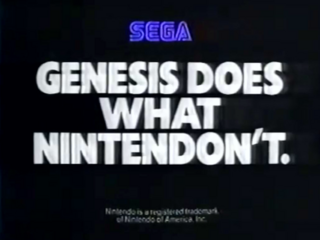Genesis Does
From Sega Retro
This teeny-tiny article needs some work. You can help us by expanding it.
Genesis Does was a Sega of America advertising campaign centered around the superiority of the new 16-bit Sega Genesis over Nintendo's popular Nintendo Entertainment System, created by Director of Marketing Al Nilsen and produced by Nebraskan advertising agency Bozell, and run from September 1990 through the following December.[1][2]
Contents
Campaign
Genesis Does stands as the earliest example of a Sega-led "attack ad", in which the campaign specifically called out the supposed inadequacies of the rival 8-bit Nintendo Entertainment System when compared to the Sega Mega Drive (Sega Genesis in this region). Previous campaigns had focused on the Genesis' ability to bring "16-bit" arcade games into the home, however this focus was dropped for what would become at least six years of Sega favourably comparing itself to the competition.
The Genesis Does campaign also coincided with a number of celebrity-endorsed Genesis games for the 1990 holiday season, including Arnold Palmer's Tournament Golf, Tommy Lasorda Baseball, Pat Riley Basketball, James 'Buster' Douglas Knockout Boxing, and most importantly to Sega, Joe Montana Football and Michael Jackson's Moonwalker.
This was not the first campaign to poke fun at a rival video game system - Atari, Mattel and Coleco had attacked each other in the early 1980s, but it was the first in the post-Nintendo age, following the North American video game crash of 1983/1984. Rivals NEC would also take aim at the NES with its TurboGrafx-16 system, while Sega would later concentrate its fire on the Super NES from mid-1991 onwards.
The Genesis Does campaign featured a large amount of Genesis games released for the console in 1989 and 1990 (alongside a few delayed to 1991), and true to the campaign's word, virtually none of these titles were released on a Nintendo console. Two exceptions exist; Altered Beast was brought to the Famicom in Japan and After Burner II was also released for Nintendo's console, with Tengen publishing it for the NES in 1989 (though strictly speaking the NES version refers to itself just as After Burner, even though it is not a port of the prequel).
Promotional material
Print advertisements
also published in:
- Electronic Gaming Monthly (US) #13: "August 1990" (1990-xx-xx)[3]
- GamePro (US) #12: "July 1990" (1990-xx-xx)[4]
- VideoGames & Computer Entertainment (US) #18: "July 1990" (1990-0x-xx)[5]
also published in:
- GamePro (US) #13: "August 1990" (1990-xx-xx)[6]
- VideoGames & Computer Entertainment (US) #19: "August 1990" (1990-0x-xx)[7]
also published in:
also published in:
- Electronic Gaming Monthly (US) #15: "October 1990" (1990-xx-xx)[9]
- GamePro (US) #15: "October 1990" (1990-xx-xx)[10]
- VideoGames & Computer Entertainment (US) #21: "October 1990" (1990-xx-xx)[11]
also published in:
- GamePro (US) #16: "November 1990" (1990-xx-xx)[12]
- Game Players Sega Guide! (US) #0101: "Vol. 1, No. 1: Fall 1990" (1990-10-xx)[13]
- Sega Visions (US) #3: "Winter 1990/1991" (1990-xx-xx)[14]
Television advertisements
References
- ↑ File:TheDanvilleNews US 1990-03-23; Page 4.png
- ↑ Sega Visions, "October/November 1990" (US; 1990-xx-xx), page 27
- ↑ Electronic Gaming Monthly, "August 1990" (US; 1990-xx-xx), page 7
- ↑ GamePro, "July 1990" (US; 1990-xx-xx), page 61
- ↑ VideoGames & Computer Entertainment, "July 1990" (US; 1990-0x-xx), page 59
- ↑ GamePro, "August 1990" (US; 1990-xx-xx), page 53
- ↑ VideoGames & Computer Entertainment, "August 1990" (US; 1990-0x-xx), page 13
- ↑ GamePro, "September 1990" (US; 1990-xx-xx), page 71
- ↑ Electronic Gaming Monthly, "October 1990" (US; 1990-xx-xx), page 69
- ↑ GamePro, "October 1990" (US; 1990-xx-xx), page 73
- ↑ VideoGames & Computer Entertainment, "October 1990" (US; 1990-xx-xx), page 39
- ↑ GamePro, "November 1990" (US; 1990-xx-xx), page 100
- ↑ Game Players Sega Guide!, "Vol. 1, No. 1: Fall 1990" (US; 1990-10-xx), page 8
- ↑ Sega Visions, "Winter 1990/1991" (US; 1990-xx-xx), page 22
- ↑ GamePro, "December 1990" (US; 1990-xx-xx), page 126
- ↑ GamePro, "March 1991" (US; 1991-xx-xx), page 72
- ↑ GamePro, "January 1991" (US; 199x-xx-xx), page 102



